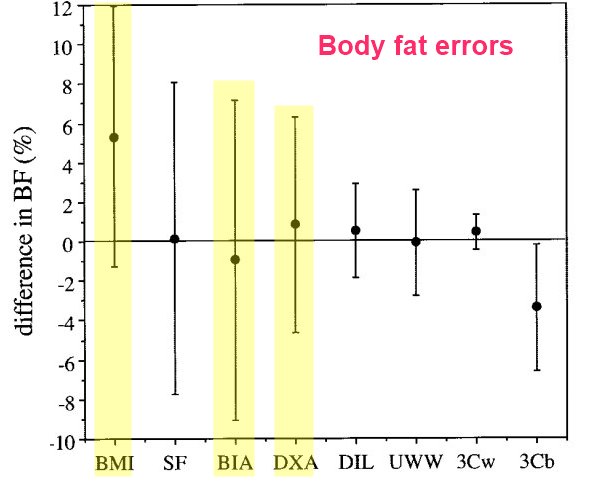Obesity of 9,000 US adults: DEXA said 72% were obese, BMI said 42% were obese
MDEdge – BMI ‘vastly underestimates’ true obesity
Chat-GPT comparison of BMI and DEXA
Body Mass Index (BMI):
BMI is the most widely used method to assess obesity and overweight status in both adults and children due to its simplicity. It's a calculation based on a person's weight and height (BMI = kg/m2).
Pros of BMI:
Simple and quick: It only requires knowledge of a person's height and weight.
Widely accepted: Most studies and clinical settings use BMI to define obesity, making it easy to compare results across different populations and studies.
Cons of BMI:
Not direct: BMI doesn't directly measure body fat. It's possible for a muscular individual to have a high BMI but low body fat percentage.
No regional fat distribution: BMI cannot tell us about the distribution of fat within the body. This is important because visceral fat (around the organs) is more strongly linked to health risks than subcutaneous fat (under the skin).
Dual-Energy X-ray Absorptiometry (DEXA):
DEXA is a more advanced method that can directly measure body composition, including bone, fat, and muscle mass.
Pros of DEXA:
Direct measurement: DEXA provides a direct and accurate measurement of body fat percentage.
Regional fat distribution: DEXA can differentiate between different types of body tissue, and thus can give information about the distribution of fat and muscle within the body.
Cons of DEXA:
Complexity: DEXA requires special equipment and trained professionals, making it less accessible and more expensive than BMI.
Radiation exposure: Although the amount of radiation from a DEXA scan is quite low, it's still a factor to consider.
Overall, while BMI is a practical tool for initial screening and population-level studies, it has its limitations. DEXA provides more accurate and comprehensive data about body composition, but its use is often limited to research settings or specific clinical circumstances due to its higher cost and complexity.
GPT comparing DEXA amd Body Impedance
Dual-Energy X-ray Absorptiometry (DEXA):
DEXA is a more advanced method that directly measures body composition, including bone, fat, and muscle mass.
Pros of DEXA:
Direct and accurate measurement: DEXA provides a direct and accurate measurement of body fat percentage.
Regional fat distribution: DEXA can differentiate between different types of body tissue, and thus can give information about the distribution of fat and muscle within the body.
Cons of DEXA:
Complexity: DEXA requires special equipment and trained professionals, making it less accessible and more expensive than other methods.
Radiation exposure: Although the amount of radiation from a DEXA scan is quite low, it's still a factor to consider.
Bioelectrical Impedance Analysis (BIA):
BIA estimates body composition by sending a small electrical current through the body and measuring the resistance to this current. The principle is that different tissues (fat, muscle, bone) conduct electricity differently.
Pros of BIA:
Simplicity and speed: BIA is a relatively simple, quick, and non-invasive method to estimate body composition.
Accessibility: BIA scales and handheld devices can be used at home, in a fitness setting, or in a clinical setting.
Cons of BIA:
Accuracy: The accuracy of BIA can be affected by many factors, including hydration status, food intake, skin temperature, and recent physical activity. Therefore, it's less accurate than DEXA.
Less detailed information: BIA does not provide as detailed information about the distribution of fat and muscle within the body as DEXA.
In conclusion, while DEXA provides more accurate and detailed information about body composition, its use is often limited to research settings or specific clinical circumstances due to its higher cost, complexity, and radiation exposure. On the other hand, BIA is a practical tool for estimating body composition in many settings, but its accuracy can be affected by various factors and it provides less detailed information compared to DEXA.
Comparision of Body Fat Measures - 2004
Body composition changes in bodybuilders: a method comparison

BMI, body mass index;
SF, skinfolds;
BIA, bioimpedance;
DXA, dual x-ray absorptiometry;
dil, dilution by deuterium;
uww, underwater weighing;
3Cw, three-component model with body water;
3Cb, three-component model with body minerals.
📄 Download the PDF from Vitamin D Life
100's of body weight scales on Amazon also measure body impedance - as low as $10
Comparison of measurement of Body Composition

Vitamin D Life – Overview Obesity and Vitamin D contains
{include}
{include}
Vitamin D Life – Obesity is associated and treated by Vitamin D
{include}
33+ Vitamin D Life pages with BMI in the title
This list is automatically updated
{LIST()}
67+ Vitamin D Life Obesity pages with WEIGHT in the title
This list is automatically updated
{LIST()}
